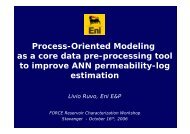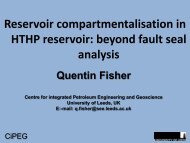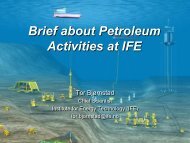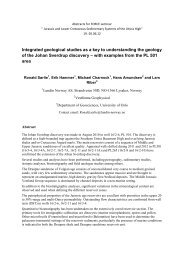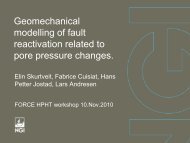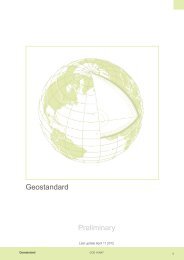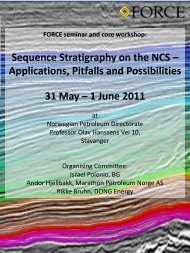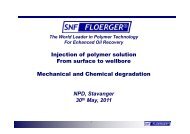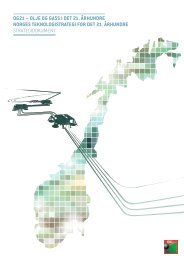Offshore field experience with Bright Water - Force
Offshore field experience with Bright Water - Force
Offshore field experience with Bright Water - Force
Create successful ePaper yourself
Turn your PDF publications into a flip-book with our unique Google optimized e-Paper software.
<strong>Offshore</strong> <strong>field</strong> <strong>experience</strong> <strong>with</strong> <strong>Bright</strong><strong>Water</strong><br />
Presenter: Nancy Lugo<br />
Chevron Upstream Europe<br />
Stavanger 20/01/2010<br />
Team Members:<br />
Nancy Lugo, David May, Elaine Campbell – Chevron Upstream Europe, Aberdeen<br />
Rick Ng, Steve Cheung – Energy Technology Company, Houston, Texas<br />
© Chevron 2005<br />
DOC ID
Agenda<br />
•What is <strong>Bright</strong><strong>Water</strong><br />
•Applications in the world<br />
•<strong>Bright</strong><strong>Water</strong> in Strathspey<br />
•Strathspey <strong>field</strong> and geology<br />
• <strong>Bright</strong><strong>Water</strong> treatment in Strathspey<br />
•Modeling process<br />
•Treatment execution<br />
•Results<br />
•Lessons Learned<br />
•Conclusions<br />
2
What is <strong>Bright</strong><strong>Water</strong><br />
• Novel particulate system for in–<br />
depth waterflood conformance<br />
control<br />
• Co-developed between Chevron,<br />
BP and Nalco<br />
• Small cross-linked polymer<br />
particles bullheaded into<br />
injection well<br />
• Propagate deep into the<br />
reservoir<br />
• Once heated polymer expands to<br />
block pore throats and prevent<br />
further fluid flow through rock<br />
• Injected water diverts into less<br />
swept zones<br />
3
STC<br />
<strong>Bright</strong><strong>Water</strong> applications<br />
Milne Pt 2004<br />
Prudhoe 2004/05 (3)<br />
NWFB 2005 (2)<br />
Arbroath 2002<br />
Strathspey<br />
2006<br />
Tangri 2006<br />
Horn Mt 2006<br />
BW for carbonates<br />
Minas 2001<br />
Kotabatak 2006/07<br />
PanAm 2006<br />
Barrow Island<br />
Completed Planned Development<br />
• 2001<br />
Minas Field – Indonesia (Chevron<br />
operated)<br />
• Extra oil observed (SPE<br />
84897)<br />
• 2002/03<br />
Arbroath, North Sea (BP)<br />
• No extra oil. Ownership<br />
changes & production issues<br />
stopped assessment of <strong>field</strong><br />
benefit.<br />
• 2004/05<br />
Alaska - Milne Point & Prudhoe Bay<br />
(BP)<br />
• Over half a million extra<br />
barrels recovered from four<br />
trial wells. Treatment cost of<br />
just $3.20 - $3.80 per barrel.<br />
• 2006<br />
Strathspey<br />
• Over 130 mboe increase first<br />
12 months. Treatment cost of<br />
$3.5 - $4 per boe.<br />
4
<strong>Bright</strong>water treatment in Strathspey Field<br />
• Subsea development<br />
• Consists of a tilted fault block (10° West)<br />
• Two Reservoirs<br />
• Brent Group (Black Oil)<br />
• Banks Group, Statfjord Fm. (Gas<br />
Condensate)<br />
• Production Mechanism<br />
• Brent: water flooding, best candidate for<br />
<strong>Bright</strong><strong>Water</strong> application<br />
• Statfjord: depletion drive<br />
• <strong>Bright</strong>water deployed in Brent reservoir<br />
Upper Brent<br />
Reservoir<br />
Lower Statfjord<br />
Reservoir<br />
Brent<br />
W<br />
Dunlin<br />
Statfjord<br />
Triassic
Strathspey Brent Geology<br />
W<br />
Main Field<br />
Reservoir Units Dip 10° West<br />
Reworked<br />
Rotated Fault Blocks<br />
E<br />
M6 Injector<br />
M10<br />
MS9 MS19<br />
2d<br />
B<br />
C<br />
D<br />
GR<br />
F<br />
ER<br />
Original OWC -9380ft TVDSS<br />
Top B7<br />
Top B6<br />
Top B5<br />
1km<br />
Top Brent Depth Structure<br />
1000ft<br />
Top B4<br />
Top B3<br />
Brent<br />
Central<br />
MS9<br />
MS19<br />
Top B2<br />
Top B1<br />
M6<br />
M10<br />
Top<br />
Dunln<br />
Log<br />
Section<br />
• Favorable mobility ratio has led to efficient sweep in<br />
general – Main Field wells<br />
• Geological heterogeneity and complex faulting in the<br />
slumped areas has led to localized early water<br />
breakthrough and poorer waterflood efficiencies.<br />
Brent<br />
South<br />
M5<br />
M9<br />
M11<br />
M3<br />
12<br />
MS14<br />
M15z<br />
M7<br />
5<br />
1km<br />
6
Cumulative RBO<br />
Produced<br />
MS14 as candidate for BW treatment<br />
MS19 Cumulative Plot 2003<br />
For Every 100 RBW Produced<br />
Top Brent Depth Structure – MS14 to MS19<br />
4000000<br />
3500000<br />
3000000<br />
2500000<br />
2000000<br />
1500000<br />
111rbo<br />
53rbo<br />
18rbo<br />
Brent<br />
Central<br />
MS19<br />
MS9<br />
M10<br />
M6<br />
MS14<br />
227rbo<br />
1000000<br />
500000<br />
0<br />
0 500000 1000000 1500000 2000000 2500000 3000000 3500000<br />
1km<br />
M9<br />
M15z<br />
Cumulative RBW Produced<br />
•Fast watercurt development at MS19<br />
after MS14 injection started<br />
•Reservoir simulation indicated high oil<br />
saturation around MS19.<br />
•Conventional water shut-off methods<br />
require well intervention<br />
• Cost prohibitive in a subsea environment<br />
• <strong>Bright</strong><strong>Water</strong> treatment recommended<br />
for well MS14<br />
• Treatment deployed in September 2006
Cross Section (W-E) along MS19 well path<br />
•Reworked fault blocks<br />
•Faults act as baffles not sealing<br />
•M6 injector give underlying support but not enough direct<br />
support <strong>with</strong>in the fault compartments<br />
•MS14 considered a good injector candidate as it could sweep<br />
north towards the faulted compartments<br />
•Hard to get efficient sweep in this area<br />
Cross Section 1 - along MS19 Well Path<br />
Top Brent Depth Structure – MS14 to MS19<br />
Brent<br />
Central<br />
1km<br />
M6<br />
MS19<br />
MS9<br />
M10<br />
M9<br />
Cross Section 1<br />
Cross Section 2<br />
MS14<br />
M15z<br />
MS19<br />
Cross Section 2<br />
Rework Fault<br />
-9380ft<br />
TVDSS OWC<br />
B5<br />
B3<br />
250m<br />
W<br />
Main Field<br />
Rework<br />
E
Cross Section MS14 to MS19<br />
•N to S fault structure indicates channeling was likely<br />
Top Brent Depth Structure – MS14 to MS19<br />
•Perm differences between layers indicated thief zones<br />
were likely<br />
•Possible improved vertical sweep efficiency was a target<br />
•MS14 was proposed as target for BW<br />
Brent<br />
Central<br />
M6<br />
MS19<br />
MS9<br />
M10<br />
Cross Section 1<br />
Cross Section 2<br />
MS14<br />
Cross Section 2 - MS14 to MS19<br />
1km<br />
M9<br />
M15z<br />
MS14<br />
MS19<br />
Rework<br />
Fault<br />
B5<br />
High Perm Layer<br />
Rework<br />
Main<br />
Field<br />
S<br />
250m<br />
-9380ft<br />
TVDSS OWC<br />
N
STC<br />
Modeling Process – <strong>Bright</strong><strong>Water</strong><br />
Temperature regime around injector<br />
Extent of open perfs in MS19<br />
•Use tracer<br />
• Determine well-well transit time and<br />
temp (help select best grade for the<br />
application)<br />
• Look at where the bulk injected BW<br />
would go<br />
MS14<br />
Temperature Profile<br />
MS19<br />
intersecting<br />
MS14<br />
Layer 7<br />
Cooling around<br />
Tracer Concentration<br />
Layer 7 (part of B5):<br />
Black lines show position of sealing or part-sealing faults<br />
Bulk BW would go –<br />
Thief layer<br />
Flank<br />
injector<br />
MS14<br />
Layer 7: grid blocks in the main area are 125ftx125ft so 700ft is cooled towards MS19<br />
Tracer in Layer 7 thief: 3 months after injection<br />
10
STC<br />
Modeling Process <strong>Bright</strong><strong>Water</strong> (cont…)<br />
Determine <strong>Bright</strong><strong>Water</strong> Grade using Lab Tests<br />
• Check activation times using bottle tests<br />
• Inject selected BW grade into sand packs to check<br />
activation time/strength<br />
• Calculate Resistance Factor<br />
• Reservoir core test to select optimum formulation<br />
11
STC<br />
Modeling Process <strong>Bright</strong><strong>Water</strong> (cont…)<br />
Predict Incremental Oil<br />
•Run full waterflood history match<br />
•Reduce permeability in the model at the<br />
position reached by tracer after heating<br />
MS19<br />
intersecting<br />
Layer 7<br />
•Rerun tracer (assess if water takes a different<br />
route)<br />
Flank<br />
injector<br />
•Predict oil recovery <strong>with</strong> and <strong>with</strong>out BW<br />
•Predict incremental oil<br />
MS14<br />
•Calculate required treatment quantity<br />
Layer 7: grid blocks in the main area are 125ftx125ft so 700ft is cooled towards MS1<br />
BW - Total Incremental: 250 - 500 mboe<br />
12
STC<br />
Treatment Execution<br />
STRATHSPEY SUBSEA LAYOUT<br />
_________________________________<br />
BRENT IGLOO<br />
BRENT 'A'<br />
BRENT RECEIVER<br />
TEE STRUCTURE<br />
Satellite wells<br />
SATELLITE WELLS<br />
MS9(B) & MS14(B)<br />
Fore and aft cluster wells<br />
16" WELGAS PIPELINE<br />
Gas to St<br />
Fergus via<br />
FLAGS system<br />
NINIAN<br />
CENTRAL<br />
16" GAS EXPORT<br />
MS14 INJECTOR<br />
M6<br />
(WI)<br />
M5<br />
(WI)<br />
'F' CLUSTER WELLS<br />
M1(S)<br />
M10(B)<br />
M2Z(S)<br />
M3(B)<br />
M4(S)<br />
Manifold<br />
'A' CLUSTER WELLS<br />
M9(B)<br />
M7(B)<br />
M8(S)<br />
Liquids to<br />
Sullom Voe<br />
through<br />
Ninian<br />
pipeline<br />
SUDS<br />
GAS EXPORT<br />
SSIV/LAUNCHER<br />
SSIV UMB.<br />
E/H CONTROLS<br />
TEXACO SSIV<br />
PROTECTION<br />
STRUCTURE<br />
2 Brent lines, 2<br />
Statfjord lines,<br />
methanol and utilities<br />
lines<br />
12" WATER INJECTION<br />
<strong>Water</strong> injection<br />
from Ninian<br />
South<br />
NINIAN<br />
SOUTHERN<br />
13
<strong>Bright</strong>water Treatment - Logistics<br />
• Planned<br />
• 140,000 litres <strong>Bright</strong>water<br />
• 70,000 litres BW Surfactant<br />
• Spiked to 58,000 BBL Injection <strong>Water</strong><br />
1.5% Polymer Concentration<br />
• Pump Time at 22,000 bpd (15bpm)<br />
• Actual<br />
2.7 DAYS<br />
• Metering Error<br />
First Half Of Polymer Treatment At 1%<br />
Second Half At 1.5%
Oil Rate (bopd)<br />
BOEPD<br />
19/12/2001<br />
19/06/2002<br />
19/12/2002<br />
19/06/2003<br />
19/12/2003<br />
19/06/2004<br />
19/12/2004<br />
19/06/2005<br />
19/12/2005<br />
19/06/2006<br />
19/12/2006<br />
19/06/2007<br />
<strong>Water</strong>cut<br />
Results<br />
8,000<br />
MS19 Pre and Post BW1<br />
0.9<br />
7,000<br />
0.8<br />
0.7<br />
6,000<br />
0.6<br />
5,000<br />
0.5<br />
4,000<br />
0.4<br />
3,000<br />
0.3<br />
2,000<br />
0.2<br />
5,000 7,000 9,000 11,000 13,000 15,000 17,000 19,000<br />
Total Fluid Rate (bpd)<br />
bopd 2003 bopd 2007 %wtcut 2003 %wtcut 2003<br />
MS19 Production History<br />
• In 2007 the watercut appeared to be<br />
more controlled.<br />
• Under similar voidage replacement<br />
conditions water cut accelerated to 80%<br />
over a matter of nine months in 2003<br />
• <strong>Bright</strong><strong>Water</strong>® slowed down the passage<br />
of water considerably between injector<br />
and producer.<br />
• Allows MS19 to flow naturally at higher<br />
fluid rates <strong>with</strong> lower water-cut.<br />
18000<br />
16000<br />
14000<br />
12000<br />
10000<br />
8000<br />
6000<br />
4000<br />
2000<br />
0<br />
• Data indicated oil production rise of 575<br />
boepd.<br />
• Incremental of 130 MBOE first year<br />
• Total incremental hydrocarbon estimated<br />
to rise to 317,300 boe<br />
Base BOE<br />
Inc BOE<br />
15
Best Practices and Lessons Learned<br />
Best Practices.<br />
• Committed cooperative efforts among operators, vendors and research<br />
insititutes can deliver innovative technologies for enhancing hydrocarbon<br />
recovery.<br />
• Investigate all data available to determine transit time between injector and<br />
producer. Consider an interwell tracer test first if there is a chance of very rapid<br />
connection between wells<br />
• Simple simulation studies add valuable insights to the design and provide useful<br />
estimation of incremental oil recovery.<br />
Lessons Learned.<br />
• Long term operator commitment is needed assign resource, monitor results and<br />
document.<br />
• Failure of of crucial subsea equipment can make monitoring of well performance<br />
very difficult for long periods until opportune availability of vessels is possible.<br />
• More thorough yard trials for pumping <strong>Bright</strong>water should be conducted <strong>with</strong> the<br />
vendor and operator personnel present.<br />
16
Conclusions<br />
• <strong>Bright</strong>water was successfully deployed via a 10 mile<br />
subsea water injection line from the Ninian South<br />
Platform<br />
• The treatment reduced the rate of water injection<br />
channeling between injector MS14 and producer MS19.<br />
• The impact on MS19 is that the well can produce at a<br />
higher total fluid rate <strong>with</strong> a lower watercut leading to<br />
increased oil production.<br />
• Incremental oil delivered in the first 12 months is<br />
130,000 boe.<br />
17
STC<br />
Any questions?<br />
18



